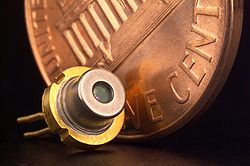Tunable laser
[6] Usually, these lines do not operate unless the gain of the strongest transition is suppressed, such as by use of wavelength-selective dielectric mirrors.
Such lasers are commonly used in optical communications applications, such as DWDM-systems, to allow adjustment of the signal wavelength.
Sample Grating Distributed Bragg Reflector lasers (SG-DBR) have a much larger tunable range; by the use of vernier-tunable Bragg mirrors and a phase section, a single-mode output range of > 50 nm can be selected.
They can be used for solar cells characterisation in a light-beam-induced current (LBIC) experiment, from which the external quantum efficiency (EQE) of a device can be mapped.
used for the development of hyperspectral imaging for early detection of retinal diseases where a wide range of wavelengths, a small bandwidth, and outstanding isolation is needed to achieve efficient illumination of the entire retina.
[18][19] Tunable sources can be a powerful tool for reflection and transmission spectroscopy, photobiology, detector calibration, hyperspectral imaging, and steady-state pump probe experiments, to name only a few.
Other tuning techniques involve diffraction gratings, prisms, etalons, and combinations of these.
[25] Multiple-prism grating arrangements, in several configurations, as described by Duarte, are used in diode, dye, gas, and other tunable lasers.

